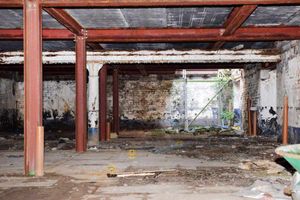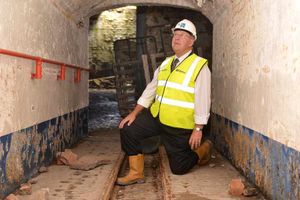Springfield Brewery in pictures: Wolverhampton relic is rising from the ashes
For years it lay derelict, a boarded up and broken down relic on the edge of the city centre.
Springfield Brewery was a shadow of its former self, ravaged by fire with buildings either fallen down or on the brink of collapse, the once proud Wolverhampton landmark resembled a ghost town, waiting for the bulldozers to move in and consign it to the history books once and for all.
Then in September last year the news broke that the University of Wolverhampton had agreed to buy the sprawling 12-acre site.
Within weeks ambitious plans were laid out to transform Springfield into a £60 million university campus that would cater for thousands of students in its dual role as the new West Midlands University Technical College (UTC) and a school of architecture.
Now 12 months down the line those plans are coming to fruition.
At the start of the month a small crew of workers moved in to start revamping the iconic pump house, a 142-year-old building near the Grimstone Street entrance to the site that sat on top of one of the five natural water springs present there.
Henry Gun-Why, director of estates at the University of Wolverhampton, has overseen the project from the outset.
















"It's been a whirlwind ride," he said. "Planning started in January and a lot of work has gone on since then to prepare the site for redevelopment.
"We got the keys to the site at the end of May, then we committed to a 999-year lease at the end of August. A week later we had a team starting work at the pump house.
"Everything has happened so quickly. We want to restore the pump house as quickly as possible, that's the first job. "There's a lot of work ahead, but it's an exciting time."
Part of the preparation for the build has involved clearing bushes from a huge area at the rear of the site, while another section of the land was dotted with hundreds of metal poles half buried in the ground, harking back to a failed housing development from the mid-2000s.
Taylor Wimpey laid the foundations for around 140 homes there in 2006, but the housing market collapsed and the scheme never got off the ground.
"It was like a field full of tombstones," added Mr Gun-Why, surveying the now cleared plot.

"It has been dormant since then. We think of this project as a phoenix from the flames. It represents a bright future and will create jobs for the people of Wolverhampton."
The remnants of the doomed project can also be seen around two buildings at the site that were set to be converted into flats. Partition walls and modern roof joists are all that remain.
The university has committed to maintaining the historical aspects of the site - right down to the iconic gatehouse on Cambridge Street which will be restored to serve as the main entrance to the campus.
And world-renowned clockmaker Smith of Derby has been commissioned to produce four clocks that will take pride of place in the tower of the main building.
Meanwhile last week it was revealed that beer brewing is likely to return to Springfield, with micro-brewery Broughs set to be invited to run operations from the site once work is complete.

Neil Howells, the university's project manager for the development, said the entire project had been inspired by the history of Springfield.
"Just look around here and you still get a great sense of what a bustling place this would have been in its heyday," said the 61-year-old, from Merry Hill, Wolverhampton.
"We don't want to completely bury those memories. Right from the start our aim is for the new buildings to maintain elements of the past once they are complete."
To that end thousands of bricks have been reclaimed from damaged sections of the buildings for use in the new build.
Dozens of elaborate leaded lights have been taken down from rotten window frames and will also find a home in the Springfield campus, while original doors will also be restored and re-fitted.
These include an oak out-sales door with sash window dating back to the opening of the brewery, through which thousands of barrels of beer would have been sold to the public.

For Mr Howells the project is something of a labour of love, his grandfather David Amor having worked at the brewery for 50 years.
"From a personal point of view it is obviously very special to be involved in developing the site," he said.
"With the family connection I was brought up knowing how important the brewery has been to Wolverhampton over the years. How many people it has employed, and how it put the old town on the map in the brewing industry.
"To see what's happening here now gives me a great sense of pride."
Mr Howells describes the development as 'a massive job', an assertion that rings true for anyone who has wandered around the plot.
And the vast scale of the site is not limited to what is visible above the ground. An entrance near the pump house opens up to reveal concrete steps that lead down to a labyrinth of damp and dark cellars.
"This is where they would have stored the finished beer in barrels before it was delivered out to pubs around the area," Mr Howells added.
"The whole place would have been like a little village in its own right, with workshops here to make the barrels. Springfield has gone from a thriving business to a wasteland, but now its on the way back."

Thriving business indeed. After opening in 1874 the site was producing around 1,500 barrels a week for William Butler and Company within 10 years.
The business continued to grow and by the 1950s it was one of the largest brewers in the Midlands. In 1960 it was sold to Mitchells & Butlers.
Brewing ceased around the early 1990s and the site served as a distribution centre until 1996 when it was taken over by delivery firm Trade Team.
There were a number of small fires at the site, but in 2004 arsonists struck and burned down large sections of the brewery.
Despite being derelict and deserted apart from the presence of micro-brewery Broughs, who took up one small building until earlier this year, guards were kept on at the site for 24 hours a day in a bid to prevent further damage to the Grade II listed buildings.
David Cooper, aged 71, from Castlecroft, released a DVD documenting the state of the brewery using video footage shot in 1997.
He said: "It's wonderful that the university has had the vision to retain so many of the traditional features of Springfield.
"The building was unsafe in so many places that in the long-term I believe it would have been completely flattened and cleared had they not stepped in.
"We've lost a lot of historical sites in Wolverhampton, so it's great to see that to a large extent Springfield has been saved."
The development is set to be split into six phases, with the campus slated to open in autumn 2016.





